The Wheelchair Guide
Your Wheelchair and Mobility Scooter Resource
Wheelchair Lifts vs Wheelchair Ramps
Thursday, September 9th, 2010
 In homes that have a staircase on the front access, it can be very difficult for wheelchair users to safely and conveniently get into and out of their home. There are a number of options available to help make this task easier, but in most cases, the wheelchair lift is the most effective and safest type of home mobility aid.
In homes that have a staircase on the front access, it can be very difficult for wheelchair users to safely and conveniently get into and out of their home. There are a number of options available to help make this task easier, but in most cases, the wheelchair lift is the most effective and safest type of home mobility aid.
Wheelchair Ramps
Traditionally, wheelchair ramps have been used to allow full access to a home. These are commonly seen on commercial buildings and often on homes as well. For non-commercial use, the most common type of wheelchair ramp is the wooden one, which is made in a manner similar to building a deck. There are a number of wheelchair ramp plans available and most capable contractors or handymen can build one, with most areas having companies that also specialize in custom wheelchair ramps. Generally, if you would not feel comfortable building your own deck, it is not a good idea to build a wooden wheelchair ramp.
In addition to wooden ramps, there are a number of pre-made metal ramps. Some of these are simple metal planks or threshold ramps, which are mainly used when there is only a step or two that must be navigated. For larger staircases, modular metal ramps are available, which come in sections and can be fitted together very easily.
While wheelchair ramps, at least wooden wheelchair ramps, are usually a good deal less expensive than a wheelchair lift, they can take up a lot of space. In the case of wooden ramps or modular ramps, it is not common for a significant amount of the front yard to be taken up by the wheelchair ramp. Smaller ramps, which are used when there is just a step or two, can make regular use of the staircase more difficult.
Wheelchair Lifts
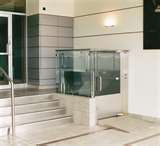 Wheelchair lifts are usually a more expensive option than building your own wooden wheelchair ramp, although modular -metal wheelchair ramps can get much more expensive and are often similar cost to a wheelchair lift. However, the added cost comes with a great deal more convenience and flexibility.
Wheelchair lifts are usually a more expensive option than building your own wooden wheelchair ramp, although modular -metal wheelchair ramps can get much more expensive and are often similar cost to a wheelchair lift. However, the added cost comes with a great deal more convenience and flexibility.
Wheelchair lifts, or vertical platform lifts, are basically a completely self-contained elevator unit, which is placed next to a staircase. Since the vertical platform lift is self-contained, there is no need to modify the home, such as you would need to do when building a residential elevator. Instead, the wheelchair lift can be placed directly next to the staircase and used to lift the user safely and quickly to the landing.
The biggest concern with an outdoor wheelchair lift is that the base that the unit sits on is well made and provides adequate drainage. A concrete base works best, although a wooden base can also be used, providing it is sturdy enough to support the weight of the vertical platform lift and its occupants.
It is also very important to consider things like overhanging branches, which could fall on the lift during a storm and damage it, as well as roof water run-off. In the case of the latter, it is very important that gutters are installed above the wheelchair lift and that ground water can not build up around the base of the device.
In addition to being easier to use, wheelchair lifts are installed on the side of a staircase, next to the landing. This means that full access to the steps will be maintained, with no obstructions.
Wheelchair Lifts and Interior Staircases
On interior staircases, a wheelchair lift is not always an option, as the lift must be installed next to the staircase’s landing. This is one of the reasons vertical platform lifts are often called “porch lifts,” as they are most often used on the front porch of a home.
For interior staircases, an inclined platform lift can sometimes be used, which provides a platform that moves along the length of the staircase, instead of vertically. These take up a lot of space though, so are more common on commercial stairways.
A Look at Manual and Electric Wheelchairs
Tuesday, March 9th, 2010
The wheelchair is probably the most recognized type of mobility vehicle, with its invention being traced back over a thousand years. However, if you were to look at one of the wheelchairs used by people during the 1600′s and compare it to one of those used today, you would be hard pressed to find similarities, aside from both having wheels and their general function.
Manual Wheelchairs
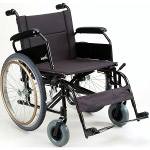 Today, wheelchairs are either manually powered or electric powered. Manual wheelchairs, or self-propelled wheelchairs, remain very popular and are often the least expensive option. Of course, there are exceptions to this rule, but generally a manual wheelchair costs about a third of what an electric wheelchair would.
Today, wheelchairs are either manually powered or electric powered. Manual wheelchairs, or self-propelled wheelchairs, remain very popular and are often the least expensive option. Of course, there are exceptions to this rule, but generally a manual wheelchair costs about a third of what an electric wheelchair would.
The general design of a manual wheelchair is based off of the 1920′s E&J Wheelchair Frame, which was a folding hollow-tubed wheelchair, designed to be easily transported. The basic design has not changed too much and the outline of the E&J wheelchair can still be seen in most modern wheelchair.
Most manual wheelchairs have a a large set of rear wheels, which can be turned by the person sitting in the wheelchair. A metal hand-rim extends from the rear wheel, providing a handhold for the user to grasp and spin the wheel, without having to touch the part that makes contact with the ground. The front wheels are usually much smaller and the front rigging of the wheelchair provides a footrest for the user, so their feet do not touch the ground.
The seat of a standard manual wheelchair is often made out of vinyl, which is looped around the metal tube framing of the wheelchair and sewn in place. However, more breathable fabrics are also available and are more common on sports wheelchairs. When not in use, the wheelchair can be folded up, making it much easier to transport.
While the majority of manual wheelchairs are self propelled, transport wheelchairs are also available, which are designed to be pushed from behind. Transport wheelchairs share a similar design, but the rear wheels are usually smaller and do not have handrims.
Electric Wheelchairs
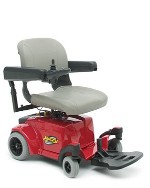 Electric wheelchairs are becoming much more common and offer the same basic functionality of a manual wheelchair, but the chair itself is powered by an electric motor, instead of the wheelchair user. The seat, which varies in size, but often resembles an office chair, is mounted atop a plastic base. The plastic base contains the electric motor and rechargeable battery that powers the wheelchair.
Electric wheelchairs are becoming much more common and offer the same basic functionality of a manual wheelchair, but the chair itself is powered by an electric motor, instead of the wheelchair user. The seat, which varies in size, but often resembles an office chair, is mounted atop a plastic base. The plastic base contains the electric motor and rechargeable battery that powers the wheelchair.
Like a manual wheelchair, electric wheelchairs provide a footrest, but the footrest is usually one piece of plastic, instead of the two individual footrests that are most common on a manual wheelchair. The standard control system for an electric wheelchair is a single joystick control that is mounted to the left or right armrest. The control system allows the wheelchair to be turned and moved by pushing on the joystick, as well as offering buttons to control the speed of the wheelchair. The range can vary depending on the model, as does the speed, but most quality electric wheelchairs can travel around 10 miles per charge and up to 4MPH.
Which is Better? Electric or Manual?
This is something that varies greatly by user and a lot of it comes down to personal preference. However, using a manual wheelchair can be quite strenuous, requiring a good deal of upper body strength, so this is often a factor. Cost also often plays a role, with many quality manual wheelchairs being available for under $500, while most electric wheelchairs cost over $2000.
Another factor to consider is where the wheelchair is going to be used and how often it will be used. A manual wheelchair may end up being easier to transport and better suited for indoor use, while for those who will be traveling across greater distances each day, an electric wheelchair might be a better choice.
Increasing Wheelchair Accessibility: The Front Steps
Monday, November 23rd, 2009
For wheelchair users, making sure that all areas of a home is accessible is very important, not just to make getting around easy, but also to address safety concerns. In most cases, ensuring a home is wheelchair friendly starts with the front entrance.
Depending on how a home is set up, the front or side door usually presents the first and sometimes only hurdle to a wheelchair user. So, finding a way to safely and cost effectively bridge this gap is very important and largely depends on the type of door in the home.
Most homes have at least one or two steps separating around most entrances, which can present a very big obstacle to those who use wheelchairs.
Small Wheelchair Ramps
If there are only a few steps, installing a small ramp is sometimes the quickest, easiest, and least expensive way of ensuring wheelchair access.
Ramps come in a variety of sizes and designs, both made out of wood and metal. Since the length of a wheelchair ramp is directly proportional to the length of the staircase, the lower the staircase, the shorter the ramp.
If the staircase is only a few feet high, it is usually possible to install a very short ramp, which can be removed or repositioned as necessary. Often, folding metal ramps are used, which are also popular for use with larger vans. If the ramp does not fold, then it is usually made as a single piece, much like a large board of plywood, but much stronger and more rigid.
One of the main advantages of using a short semi-permanent ramp is cost, as these tend to be the least expensive to build or purchase. They can also be quickly removed as needed and typically don’t take up all that much space. However, these types of ramps only work on very short stairways.
For larger staircases, a much longer ramp is needed. Depending on space, this sometimes means creating a zig-zag design, rather than a straight ramp. Usually, as a result of how much longer of a ramp you would need for a larger staircase, installing the ramp on the front of the house is a necessity.
Large Wheelchair Ramps
Like the smaller ramps, it is possible to go with a metal or wooden design. The wooden design is popular, as the materials to build a wheelchair ramp are not very expensive, so if you know someone who is handy, building your own wheelchair ramp is often the best choice from a monetary standpoint. Metal wheelchair ramps are also available and come in sections, making it a modular wheelchair ramp. The number of sections varies by the height of the steps and installing the ramp is simply a matter of connecting the individual sections.
Wheelchair ramps are popular as they do not require any electricity to use and usually don’t have any moving parts, so there are few points that could fail. In most cases, providing the proper type of wood is used and faulty boards are replaced as needed, a wooden wheelchair ramp will last as long as needed.
However, wheelchair ramps do require that the user is able to move themselves along the ramp and depending on the height of the staircase, they can take up a great deal of yard space.
Wheelchair Lifts
Wheelchair lifts or, as they are typically referred to in the industry, vertical platform lifts, represent one of the easiest and safest ways of increasing staircase accessibility. For all intensive purposes, a vertical platform lift is simply a self-contained elevator. Unlike the type of elevators you would see inside of a building, wheelchair lifts do not require a large shaft in the home or much modification to the home. Instead, wheelchair lifts need only be placed next to the staircase landing on a strong surface made out of wood or concrete.
To use a wheelchair lift, the user simply drives their wheelchair onto its platform and activates the call buttons. The platform than lowers or rises the distance of the staircase. One of the advantages of a wheelchair lift is that it can be used easily and requires very little effort on the part of the wheelchair user or caretaker. Simply pushing a button is all it takes to make the stairs safer. Wheelchair lifts also do not take up much front yard space.
However, wheelchair lifts represent the most expensive option, costing significantly more than building your own wheelchair ramp.
Increasing Accessibility With Wheelchair Ramps and Vertical Platform Lifts
Friday, September 18th, 2009
One of the most common dilemmas faced by those who use wheelchairs and mobility scooters is how to safely and easily move these devices into and out of the home. There are several popular options, which include installing a wheelchair ramp or using a vertical platform lift.
Wooden Wheelchair Ramps
 Wheelchair ramps are often found in commercial settings made out of poured concrete, but they are also popular in residential settings. For use in homes, the concrete wheelchair lift is not as popular though, with most people using a wooden wheelchair ramp or a modular metal wheelchair ramp.
Wheelchair ramps are often found in commercial settings made out of poured concrete, but they are also popular in residential settings. For use in homes, the concrete wheelchair lift is not as popular though, with most people using a wooden wheelchair ramp or a modular metal wheelchair ramp.
In the case of wooden ramps, a number of plans are available, which can built by those who are reasonably handy with tools and knowledgeable with woodwork. There are usually a number of local handymen who can be hired to build a wooden wheelchair ramp as well.
It is important to invest in quality treated lumber, which will be able to withstand water and the elements. While a wooden wheelchair ramp is usually less expensive, the lumber and other building supplies can quickly add up.
Modular Metal Wheelchair Ramps
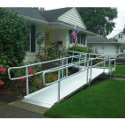 Modular metal ramps are also popular, as they only need to be fitted together at the home, greatly reducing the installation time and cost. However, a modular metal ramp typically costs a good deal more than it would cost to build a wooden wheelchair ramp. It is more durable though and many like the shiny metal look over the wooden feel offered by a wooden wheelchair ramp.
Modular metal ramps are also popular, as they only need to be fitted together at the home, greatly reducing the installation time and cost. However, a modular metal ramp typically costs a good deal more than it would cost to build a wooden wheelchair ramp. It is more durable though and many like the shiny metal look over the wooden feel offered by a wooden wheelchair ramp.
Threshold Ramps
When deciding what type of ramp to purchase, it is important to consider whether a full ramp is needed or simply a threshold ramp. For very short distances, a threshold ramp can be a very cost effective type of wheelchair ramp, which is basically a metal plank that attaches to the door frame and can usually bridge a few steps. However, a threshold ramp will only work on very short distances.
Drawbacks of Using a Wheelchair Ramp
While wheelchair ramps can be cost effective, they have two major drawbacks. One is the amount of space they take up in the yard. The length of the ramp is directly related to the height of the staircase, so in many cases, a wheelchair ramp will have to be very long, taking up a good deal of real estate on the lawn. Not only can this be a drawback when it comes to how the home looks, but for those with animals or small children, this loss of yard space can greatly affect how the home is used.
The other main drawback is that even though the incline is not very large, you still must move the wheelchair up what is essentially a hill when you use a wheelchair ramp. In the case of some older wheelchair users and those who use manual wheelchairs, this might not be possible. Even if you have someone to push the person up the ramp, it can require a great deal of effort and there are some risks associated with wheelchair ramps.
Vertical Platform Lifts
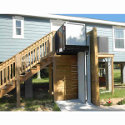 Another option for those who use mobility vehicles, like wheelchairs and electric scooters, is the vertical platform lift. Vertical platform lifts are also called wheelchair lifts and provide what is essentially a mini-elevator that is installed next to the front steps. A metal platform, of varying size, is provided for the wheelchair user to drive onto. When activated, the platform rises upwards until it is parallel with the front steps.
Another option for those who use mobility vehicles, like wheelchairs and electric scooters, is the vertical platform lift. Vertical platform lifts are also called wheelchair lifts and provide what is essentially a mini-elevator that is installed next to the front steps. A metal platform, of varying size, is provided for the wheelchair user to drive onto. When activated, the platform rises upwards until it is parallel with the front steps.
While in functionality a wheelchair lift is very similar to an elevator, the entire unit is self contained, so there is no need to build an elevator shaft or worry about running any cables. Instead, once the wheelchair lift is assembled, it can simply be placed where it is needed and turned on, instantly bridging the gap between the ground and the front steps.
These devices are also called porch lifts, because they are usually used on the front porch of a home, but they are also popular in schools and other commercial buildings.
Porch lifts include a number of safety settings, with doors available for both the top and bottom of the staircase. This can be important, because to install a porch lift it is usually necessary to remove a section of the handrail at the top of the landing. A door with call button at the top of the landing can serve as a gate, preventing falls when the porch lift is at the bottom of the staircase.
Vertical platform lifts are very popular because they are easy to install and do not take up much space. As a result, they can be used in many areas where a wheelchair ramp would not fit or would take up too much yard space. These wheelchair lifts are also quite powerful, with most supporting around 700 pounds and can span distances of up to 12 feet. In some cases where the porch is very high off the ground, the amount of space required to make a wheelchair ramp would be very excessive, where using a wheelchair lift requires only a few feet.
Due to their weight capacity, wheelchair lifts can also be used as service elevators, making moving heavy objects up the stairs much easier. It is also not uncommon for two people to use the porch lift at once, with one in a wheelchair or mobility scooter and the other behind them.
Wheelchair lifts do, however, cost more than most wheelchair ramps, although this is not always the case with modular metal wheelchair ramps, which can end up being pretty expensive as well.
Senior Accessibility Tools: Walkers, Wheelchairs and Mobility Scooters
Friday, August 7th, 2009
It is often very difficult for seniors to get around and walk for an extended period of time. This restriction can ultimately has a very big impact on their day to day life, as it is necessary to avoid many of the things they enjoy, such as going to the park with the family or walking around the neighborhood. There are three main devices used to address this issue, namely the walker, the mobility scooter, and the wheelchair.
A Brief Look at Walkers
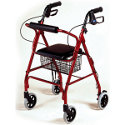 Walkers have been popular for many years now and come in a number of different styles. Typically, walkers provide system that makes contact with the floor at four different points, to provide increased stability as compared to a cane. Hand holds are provided for both arms and the senior is able to move forward, leaning against the walker for support.
Walkers have been popular for many years now and come in a number of different styles. Typically, walkers provide system that makes contact with the floor at four different points, to provide increased stability as compared to a cane. Hand holds are provided for both arms and the senior is able to move forward, leaning against the walker for support.
Over the past few years, rollators, which are essentially rolling walkers, have become much more popular. Many seniors find rollators much easier to use, because instead of having to lift the walker up with every few steps, they can simply roll it forward. Most rollators also double as a seat and provide a storage basket. There are also hand brakes on the hand holds, which can be locked in place when the senior is not moving.
A Brief Look at Mobility Scooters
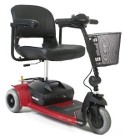 Mobility Scooters are very popular among seniors and provide a motorized way to get around. They have an elongated flat base, with 3 or 4 wheels, and are controlled by a set of handlebars, called a tiller, that extends from the front of the electric scooter. A chair is positioned towards the rear of the mobility scooter.
Mobility Scooters are very popular among seniors and provide a motorized way to get around. They have an elongated flat base, with 3 or 4 wheels, and are controlled by a set of handlebars, called a tiller, that extends from the front of the electric scooter. A chair is positioned towards the rear of the mobility scooter.
Most mobility scooters have a pretty significant range, with some traveling over 15 miles on a single battery charge. Using one allows the senior to get around with ease, traveling over pretty much any type of terrain. However, some are only designed for tightly packed ground.
Electric mobility scooters are powerful aids, used by many seniors and others who have difficulty walking. They can be used both indoors and outdoors, providing an easy and fun way to increase accessibility.
A Brief Look at Wheelchairs
 Wheelchairs are also a popular tool used by seniors who have difficulty walking, however since a wheelchair requires a lot of physical effort to use, they can not always be used independently. Instead, it is usually necessary to rely on someone to push the wheelchair from behind.
Wheelchairs are also a popular tool used by seniors who have difficulty walking, however since a wheelchair requires a lot of physical effort to use, they can not always be used independently. Instead, it is usually necessary to rely on someone to push the wheelchair from behind.
Electric wheelchairs are available as well, but are usually considerably more expensive than mobility scooters. However, unlike mobility scooters, an electric wheelchair can be driven directly up to a table or desk, without having to switch to a chair. So, many people find electric wheelchairs more convenient than mobility scooters.
Incline Platform Lifts and Vertical Platform Lifts
Wednesday, July 29th, 2009
Wheelchair users, both at home and away, usually have trouble with areas that have stairs. Areas with stairs can be very difficult for those using wheelchairs to access. Around the home, this can greatly decrease accessibility, as most homes have a staircase on the front of the home and may also have one inside. To help increase accessibility at home, many people use vertical platform lifts and inclined platform lifts, both of these devices greatly increase accessibility by allowing a wheelchair user full access to their home.
What are Vertical Platform Lifts?
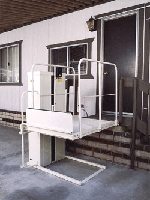 Vertical platform lifts, which are commonly called wheelchair lifts, are most often used on the front steps of a home. The entire unit is basically an elevator, with a strong lifting motor, elevator shaft, and lifting platform all rolled into one single unit.
Vertical platform lifts, which are commonly called wheelchair lifts, are most often used on the front steps of a home. The entire unit is basically an elevator, with a strong lifting motor, elevator shaft, and lifting platform all rolled into one single unit.
A wheelchair lift is placed next to the landing of a staircase. A large metal rectangle or square is provided, which the wheelchair user drives their wheelchair directly onto. The platform then raises vertically to the top of the landing and back down again. Depending on what type of vertical platform lift is used, there are many safety features available. For instance, many include locking doors on the platform, to reduce falls. It is also common for a door to be placed at the top of the landing.
Vertical platform lifts can usually support a minimum of 500 pounds, although this can vary by model, with some supporting more than 700 pounds. Due to their weight capacity, vertical platform lifts can be used by those with manual wheelchairs, electric wheelchairs, and mobility scooters. It is also often possible for multiple people to use the wheelchair lift at once, providing they do not exceed the weight capacity of the device.
While wheelchair lifts work very well on the front of the house, they do not always work on interior staircases. This is because the lift must be placed next to the landing and then raises the user up to the top of the landing. For many interior staircases, this setup just simply does not work.
Inclined Platform Lifts
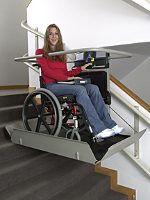 To provide interior access to a home with an interior staircase, it is often necessary to use an incline platform lift. Inclined platformed lifts provide a metal track that is attached to the wall of the staircase and runs its entire length. The wheelchair user is carried up the staircase on a platform, which is attached to the metal track.
To provide interior access to a home with an interior staircase, it is often necessary to use an incline platform lift. Inclined platformed lifts provide a metal track that is attached to the wall of the staircase and runs its entire length. The wheelchair user is carried up the staircase on a platform, which is attached to the metal track.
Inclined platform lifts can be used on most types of staircases, including curved ones. However, they do take up a good deal of space on the staircase. This is because the platform that carries the wheelchair user must be large enough for the person and their wheelchair, while also containing guard rails and an electric motor. So, an incline wheelchair lift may not fit on smaller staircases.
Inclined wheelchair lifts can usually be used by those in manual wheelchairs and electric wheelchairs, as well as people using mobility scooters. An incline platform lift operates very similarly to a stair lift, which is used by seniors who have difficulty using the stairs.
Both vertical platform lifts and inclined platform lifts are very popular in commercial settings, such as schools, churches, and office buildings.
Deciding Between Wheelchair Lift or a Wheelchair Ramp
Monday, July 27th, 2009
For someone who relies upon a wheelchair or other type of mobility vehicle, using the stairs can be very difficult, if not impossible. As a result, when away from home it is typically necessary to avoid areas with staircases. However, at home this is often not a practical response, as avoiding the staircase might mean you can not get into or out of your own home. To improve accessibility and make it easier to gain access to their home, many wheelchair users choose to install a wheelchair ramp or a vertical platform lift on their front steps.
Wheelchair Ramps
In some instances, choosing to install a wheelchair ramp will be the least expensive option to improve accessibility. Many people custom build a wheelchair ramp out of wood or hire a company to do so, which can be very affordable. It is also possible to buy a modular wheelchair ramp kit, which is made of metal and comes in sections. The height of the staircase dictates how many sections are required and when the ramp arrives, the individual sections are joined together.
When there is only one or two steps that must be overcome, a number of threshold wheelchair ramps are available, which are inexpensive and do not require much installation.
While in some cases a wheelchair ramp is less expensive, in the case of modular wheelchair ramps, there is often little difference in the cost of a vertical platform lift. Wheelchair ramps can also take up a lot of space in the yard, with the amount of space dependent on how high the staircase is. Using a wheelchair ramp is also sometimes difficult for those who use manual wheelchairs.
Wheelchair Lifts
Vertical platform lifts are basically a self contained elevator, which includes an elevator shaft, lifting motor, and lifting platform, all in one unit. Vertical platform lifts, which are often called wheelchair lifts, are installed next to a staircase’s landing and raise vertically between the ground and the landing of the staircase. The user simply maneuvers their wheelchair onto the wheelchair lifts platform and pushes a button, with the wheelchair lift doing the rest.
Most wheelchair lifts have a default lifting height that is around four feet. The device can then usually be upgraded to up to 12 feet, depending on the needs of the user. Most wheelchair lifts support around 500 pounds, with models available that can support over 700 pounds. As long as the lifts weight capacity is not exceeded, multiple people can use the wheelchair lift at once, which can be very useful for caregivers.
Vertical platform lifts require a solid base that is designed to support both the weight of the lift, which is quite heavy, and the weight of the people who will be using the device.
While wheelchair lifts are very easy to use and make using the stairs simple and trouble free, they do typically cost more than a wheelchair ramp, although this is not always the case with modular wheelchair ramps. Most wheelchair ramps cost between $3,500 and $12,000.
Deciding between a wheelchair lift or a wheelchair ramp is an important choice, which should take into account the location where the device is needed, as well as the physical attributes of the person who will be using it.
Vertical Platform Lifts vs Wheelchair Ramps
Tuesday, July 21st, 2009
For those that use wheelchairs, the stairs can present an obstacle that is very difficult to overcome. In some cases, it is possible to simply avoid traveling in areas that have stairs. However, around the home simply avoiding the stairs is typically neither practical or possible. There are several options to help make a homes staircase more accessible, but most people either install a vertical platform lift or a wheelchair ramp. Both of these options have their own advantages and disadvantages, which should be carefully weighed when making a home accessible.
Vertical Platform Lifts
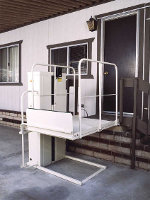 Vertical platform lifts are one of the most efficient ways of allowing a wheelchair user to travel over the stairs. Vertical platform lifts, which are often referred to as wheelchair lifts, are basically like a self contained elevator. The lifting platform, motor, and elevator shaft are all contained in a single unit, which can be placed next to a staircase to improve accessibility. The lifting height varies by model, but most have a default lifting height of around four feet, which can then be upgraded to about twelve feet.
Vertical platform lifts are one of the most efficient ways of allowing a wheelchair user to travel over the stairs. Vertical platform lifts, which are often referred to as wheelchair lifts, are basically like a self contained elevator. The lifting platform, motor, and elevator shaft are all contained in a single unit, which can be placed next to a staircase to improve accessibility. The lifting height varies by model, but most have a default lifting height of around four feet, which can then be upgraded to about twelve feet.
Vertical platform lifts are plugged into a normal electrical outlet and provide a platform for the user to drive their wheelchair onto. Then, the platform can be raised and lowered to allow full access to the home. Some wheelchair lifts include locking gates, both on the lifting platform itself, as well as at the top of the staircase landing to increase safety. Locks are also available, which may be required for commercial wheelchair lifts.
Usually the weight capacity of a vertical platform lift is at least 500 pounds, although some can support more than this. It is possible for more than one person to use the wheelchair lift at once, providing this does not exceed the weight capacity. They can also be used to move boxes or other items up and down the stairs.
Vertical platform lifts require a strong base that can support the weight of the lift, as well as the weight of the people using it. The base can be made from concrete or wood, providing it is sufficient to support the weight and stable.
The cost of a vertical platform lift varies, but usually they cost between $3,500 and $11,000. The installation of a vertical platform lift is straightforward and not very difficult, but the unit itself can be very heavy, so getting it in place may be difficult for some.
Wheelchair Ramps
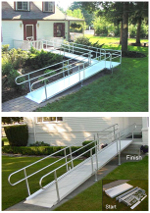 Installing a wheelchair ramp will often be a lower cost alternative to a wheelchair lift. Ramps can be custom made out of wood or metal ramp kits can be bought and assembled. The metal ramp kits typically come in sections, which are assembled at the home, and are referred to as modular wheelchair ramps. The height of the staircase will determine how many sections are needed. In some cases, modular wheelchair ramp kits can prove to be just as expensive as a wheelchair lift.
Installing a wheelchair ramp will often be a lower cost alternative to a wheelchair lift. Ramps can be custom made out of wood or metal ramp kits can be bought and assembled. The metal ramp kits typically come in sections, which are assembled at the home, and are referred to as modular wheelchair ramps. The height of the staircase will determine how many sections are needed. In some cases, modular wheelchair ramp kits can prove to be just as expensive as a wheelchair lift.
Wheelchair ramps offer the advantage of not requiring any electricity to function and since there are no moving parts, there is little about the ramp that can break. However, wheelchair ramps can take up a lot of space in a persons yard and the higher the staircase, the more space they will take up. Using a ramp can also prove to be very strenuous for those who use a manual wheelchair.
When choosing between a wheelchair ramp and a vertical platform lift, it is important to consider the location where the accessibility aid will be installed, as well as the condition of the person who will be using the device. However, for small staircases, which consist of only a step or two, there are a number of threshold ramps available that will be much more practical than a wheelchair lift would be.
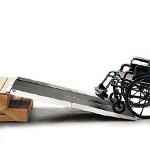 For very short staircases, of only a few steps, a simple metal ramp is the easiest and least expensive option. These come in a variety of designs, but are usually between 3′ and 6′ long. The ramp, which is made out of lightweight metal and usually has a non-skid textured backing, is simply placed onto the landing of the staircase, with some offering lightweight clamps that help hold the ramp in place. The wheelchair user can then drive up or down the ramp, which can be set up or removed in minutes.
For very short staircases, of only a few steps, a simple metal ramp is the easiest and least expensive option. These come in a variety of designs, but are usually between 3′ and 6′ long. The ramp, which is made out of lightweight metal and usually has a non-skid textured backing, is simply placed onto the landing of the staircase, with some offering lightweight clamps that help hold the ramp in place. The wheelchair user can then drive up or down the ramp, which can be set up or removed in minutes.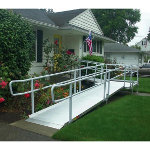 For larger staircases, a much larger wheelchair ramp is required. These often are custom built out of wood, with many free wheelchair ramp plans available online. Wooden wheelchair ramps are usually a fairly cost effective option and can be built by most handymen. It is also usually possible to hire most carpenters to build a wooden wheelchair ramp.
For larger staircases, a much larger wheelchair ramp is required. These often are custom built out of wood, with many free wheelchair ramp plans available online. Wooden wheelchair ramps are usually a fairly cost effective option and can be built by most handymen. It is also usually possible to hire most carpenters to build a wooden wheelchair ramp. 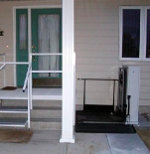 Wheelchair lifts are also a popular choice for those who use mobility scooters and electric wheelchairs, with these devices being very similar to an elevator in the way they work. The wheelchair lift, which is referred to as a vertical platform lift in the home medical industry, is placed next to the landing of the staircase, raising and lowering the wheelchair user on a metal platform.
Wheelchair lifts are also a popular choice for those who use mobility scooters and electric wheelchairs, with these devices being very similar to an elevator in the way they work. The wheelchair lift, which is referred to as a vertical platform lift in the home medical industry, is placed next to the landing of the staircase, raising and lowering the wheelchair user on a metal platform.